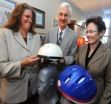(Press-News.org) Mankind's emissions of fossil carbon and the resulting increase in temperature could prove to be our salvation from the next ice age. According to new research from the University of Gothenburg, Sweden, the current increase in the extent of peatland is having the opposite effect.
"We are probably entering a new ice age right now. However, we're not noticing it due to the effects of carbon dioxide", says researcher Professor Lars Franzén.
Looking back over the past three million years, the earth has experienced at least 30 periods of ice age, known as ice age pulses. The periods in between are called interglacials. The researchers believe that the Little Ice Age of the 16th to 18th centuries may have been halted as a result of human activity. Increased felling of woodlands and growing areas of agricultural land, combined with the early stages of industrialisation, resulted in increased emissions of carbon dioxide which probably slowed down, or even reversed, the cooling trend.
"It is certainly possible that mankind's various activities contributed towards extending our ice age interval by keeping carbon dioxide levels high enough," explains Lars Franzén, Professor of Physical Geography at the University of Gothenburg.
"Without the human impact, the inevitable progression towards an ice age would have continued. The spread of peatlands is an important factor."
Peatlands act as carbon sinks, meaning that they absorb carbon dioxide from the atmosphere. They are a dynamic landscape element and currently cover around four percent of the earth's land area. Most peatlands are found in temperate areas north and south of the 45th parallel.
Around 16 percent of Sweden is covered by peatland. Peatlands grow in height and spread across their surroundings by waterlogging woodlands. They are also one of the biggest terrestrial sinks of atmospheric carbon dioxide. Each year, around 20 grams of carbon are absorbed by every square metre of peatland.
"By using the National Land Survey of Sweden's altitude database, we have calculated how much of Sweden could be covered by peatlands during an interglacial. We have taken a maximum terrain incline of three degrees as our upper limit, and have also excluded all lakes and areas with substrata that are unsuitable for peatland formation."
The researchers found that around half of Sweden's surface could be covered by peat. In such a case, the carbon dioxide sink would increase by a factor of between six and ten compared with the current situation.
"If we accept that rising levels of carbon dioxide in the atmosphere lead to an increase in global temperature, the logical conclusion must be that reduced levels lead to a drop in temperature."
The relationship between carbon dioxide and temperature is not linear. Instead, lower levels result in a greater degree of cooling than the degree of warming achieved by a corresponding increase.
"There have been no emissions of fossil carbon during earlier interglacials. Carbon sequestration in peatland may therefore be one of the main reasons why ice age conditions have occurred time after time."
Using calculations for Swedish conditions, the researchers are also producing a rough estimate of the global carbon sink effect if all temperate peatlands were to grow in the same way.
"Our calculations show that the peatlands could contribute towards global cooling equivalent to five watts per square metre. There is a great deal of evidence to suggest that we are near the end of the current interglacial."
### Professor Franzén and three other researchers have published their findings in the journal Mires and Peat.
1. Franzén, L.G., F. Lindberg, V. Viklander & A. Walther (2012) The potential peatland extent and carbon sink in Sweden, as related to the Peatland / Ice Age Hypothesis.
Mires and Peat 10(8):1-19. http://www.mires-and-peat.net/map10/map_10_08.pdf
Contact:
Lars Franzén, Professor of Physical Geography
Department of Earth Sciences, University of Gothenburg
+46 (0)31 786 1958,
+46 (0)706 198267,
lars@gvc.gu.se
Carbon dioxide – our salvation from a future ice age?
2012-11-08
ELSE PRESS RELEASES FROM THIS DATE:
Pull with caution
2012-11-08
As nanotechnology progresses, it becomes increasingly important to know in detail the dynamics of the nanoworld (the world at the scale of a millionth of a millimeter). What happens, for example, when we try to drive a polyelectrolyte (a long chain of electrically charged molecules, such as DNA) through a nanopore if knots cause the translocation process to jam? It's not a pointless question, because now a new DNA sequencing method to electrochemically analyze every single strand by driving it through a nanopore, is being developed. Since those strands tend to tangle up ...
Environmentally friendly chemistry important for manufacturing pharmaceuticals
2012-11-08
Limiting the quantity of catalysts – substances that trigger a chemical reaction – used in the manufacture of pharmaceuticals is important, and research from the University of Gothenburg, Sweden, has now demonstrated that small quantities of copper work well in this respect.
"This is an important finding, not just academically but also for industry," says chemist Per-Fredrik Larsson.
Catalysis is an incredibly valuable tool in the field of chemistry, with the Haber-Bosch process being one of the most important catalytic processes in the world. It is used to manufacture ...
What if the nanoworld slides
2012-11-08
A study published by Andrea Vanossi, Nicola Manini and Erio Tosatti - three SISSA researchers - in PNAS (Proceedings of the National Academy of Sciences) provides a new tool to better understand how sliding friction works in nanotribology, through colloidal crystals.
By theoretically studying these systems of charged microparticles, researchers are able to analyze friction forces through molecular dynamics simulations with accuracy never experienced before.
"There are several and very concrete potentialities", stated Andrea Vanossi, one of the members of the research ...
The brain of OCD sufferers is more active when faced with a moral dilemma
2012-11-08
Patients with obsessive-compulsive disorder are characterised by persistent thoughts and repetitive behaviours. A new study reveals that sufferers worry considerably more than the general population in the face of morality problems.
Along with the help of experts from the Barcelona's Hospital del Mar and the University of Melbourne (Australia), researchers at the Hospital de Bellvitge in Barcelona have proven that patients with obsessive-compulsive disorder, known as OCD, are more morally sensitive.
"Faced with a problem of this type, people suffering from this type ...
Cambridge software improves quality of sound for hearing aid users
2012-11-08
A new software product developed by researchers at the University of Cambridge could greatly improve sound perception for users of hearing aids.
The software prescribes the amount of amplification of high-frequency sounds required to restore the audibility of such sounds. This increases the frequency range of sound that individuals with hearing loss are able to detect, improving speech perception, sound localisation and the ability to hear certain musical sounds, when compared with current methods. Results of an evaluation of the software were published recently in the ...
New habitable zone super-Earth found in exosolar system
2012-11-08
Washington, D.C.—Astronomers have discovered a new super-Earth in the habitable zone, where liquid water and a stable atmosphere could reside, around the nearby star HD 40307. It is one of three new super-Earths found around the star that has three other low-mass planets orbiting it.
HD 40307 is a dwarf star that is somewhat smaller and less luminous than the Sun that is about 42 light years away (12.88 parsecs). The previously discovered planets around it are called hot super-Earths because they orbit too close to the star to support life.
The international team, including ...
Study: Education levels in Asian American neighborhoods affect residents' health
2012-11-08
WASHINGTON, DC, November 8, 2012 — Higher neighborhood education is associated with better self-rated health among Asian Americans who live in Asian ethnic neighborhoods, but this correlation between individual health and neighborhood education levels does not exist for Asian Americans living in non-Asian neighborhoods, according to a recent study in the Journal of Health and Social Behavior.
"When Asian Americans live in neighborhoods that are not Asian ethnic neighborhoods, the education level of the neighborhood doesn't affect their health," says Emily Walton, an ...
Making memories: Drexel researchers explore the anatomy of recollection
2012-11-08
What was your high school mascot? Where did you put your keys last night? Who was the first president of the United States?
Groups of neurons in your brain are currently sending electromagnetic rhythms through established pathways in order for you to recall the answers to each of these questions. Researchers in Drexel's School of Biomedical Engineering, Science and Health Systems are now getting a rare look inside the brain to discover the exact pattern of activity that produces a memory.
Dr. Joshua Jacobs, a professor in Drexel's School of Biomedical Engineering, ...
Going with your gut
2012-11-08
Decision-making is an inevitable part of the human experience, and one of the most mysterious. For centuries, scientists have studied how we go about the difficult task of choosing A or B, left or right, North or South — and how both instinct and intellect figure into the process. Now new research indicates that the old truism "look before you leap" may be less true than previously thought.
In a behavioral experiment, Prof. Marius Usher of Tel Aviv University's School of Psychological Sciences and his fellow researchers found that intuition was a surprisingly powerful ...
Inpatient brain injury education increases bike helmet use, study finds
2012-11-08
AUGUSTA, Ga. – A 30-minute brain injury education program taught in the hospital may increase children's use of bicycle helmets, Georgia Health Sciences University researchers report.
The researchers provided bicycle helmet safety and brain injury prevention information to 120 patients age 5 to 18 at Georgia Health Sciences Children's Medical Center and found that helmet usage increased by 72.5 percent within the first month following the program – from only 11 children reporting wearing a bicycle helmet on every ride to 98 always wearing helmets.
"This is a big step ...




